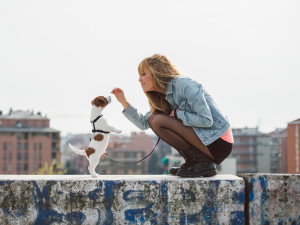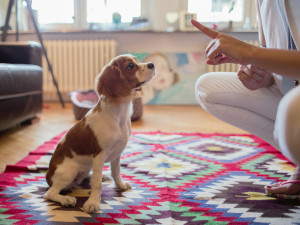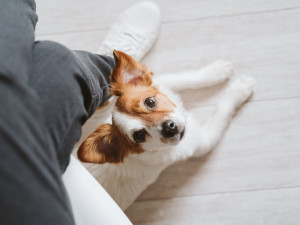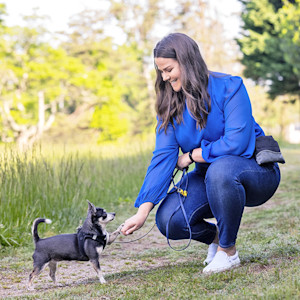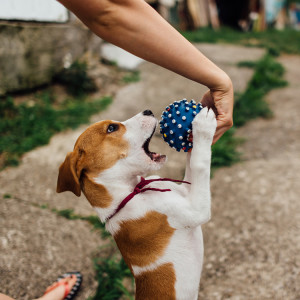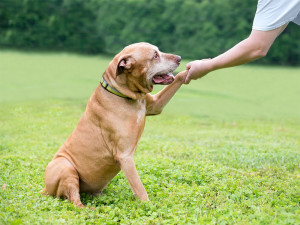A Step-by-Step Guide to Teaching Your Dog to Use a Dog Door
Your pup will be a pro in no time.
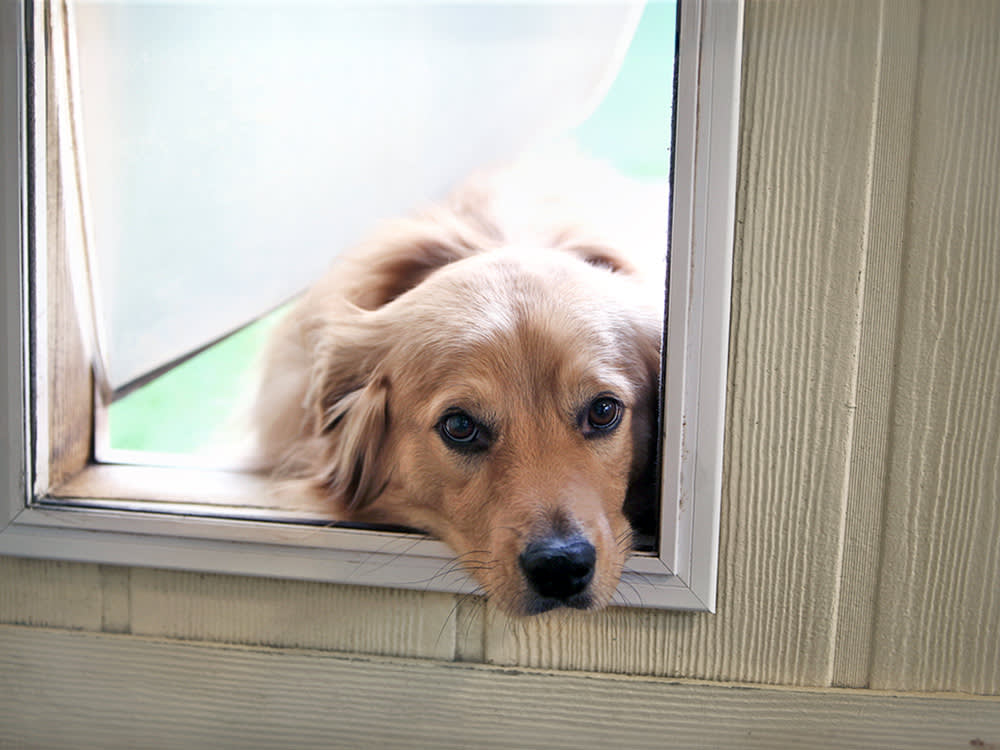
Share Article
In This Article:
Benefits of Using a Dog Dooropens in a new tab What to Consider Before You Decide to Install a Dog Dooropens in a new tab Dog Door Training Checklistopens in a new tab How to Choose the Right Dog Door for Your Dogopens in a new tab Step-by-Step Guide to Teach Your Dog to Use a Dog Dooropens in a new tab Troubleshooting Common Challenges with Dog Door Trainingopens in a new tab Bottom Line: Training Your Dog to Use a Dog Dooropens in a new tab Frequently Asked Questionsopens in a new tab
Have you ever stood by the back door, waiting for your dog to decide whether they want to go outside or stay inside, only for them to change their mind five minutes later? It’s even worse when it’s four in the morning and your pup wakes you in the middle of a good dream.
Installing a dog dooropens in a new tab may be a game-changer. A well-trained pup who confidently and independently uses a dog door means fewer interruptions, fewer accidents, less irritation, and more freedom for both of you. With the right training approach and positive reinforcement, dogs can typically use a doggie door within a few days.

littleKin™ is Kinship’s home just for puppy and kitten parents. Bop over to check out expert advice, new pet tools, and special deals—all curated for your newest family member.
opens in a new tabWhile some dogs learn to use a dog door quickly, others stare at it as if you’ve introduced them to an alien. If your dog hesitates, don’t worry. Teaching your pupopens in a new tab to use a dog door is simple – you just patience, consistency, and a few tasty treats.
Follow this guide to make the transition smooth and stress-free.
Benefits of using a dog door
There are many benefits of using a dog door, including:
Independence for your dog. Your pup can go in and out whenever they please, reducing boredom and anxiety.
Fewer accidents. No more waiting for you to open the door while they desperately signal their need to go outside.
More exercise and mental stimulation. A dog exploring the yard gets more physical activity and mental enrichment.
Convenience for pet parents. No more interrupted Zoom calls or waking up at all hours to let them outside.
Improved behavior. Bored dogs develop destructive habits. A dog door provides an outlet for energy, reducing the chances of chewing on furniture or excessive barking.
What to consider before you decide to install a dog door
Before installing a dog dooropens in a new tab, consider a few factors to ensure it’s the right choice for your home and pup.
Size matters. The door should be large enough to accommodate your dogopens in a new tab comfortably, with an inch or two of wiggle room to spare. If you have a growing pup, choose a dog door for their prospective adult size.
Security is another significant concern. Dog doors can be entry points for unwanted visitors (like raccoons). Options like locking mechanisms or electronic doors will open for your dog’s collar tag, adding extra protection.
Weatherproofing is essential. If you live in an area with extreme temperatures or frequent storms, choose an insulated dog door to prevent drafts and maintain energy efficiency.
Temperament and training readiness play a role. Confident, curious dogs learn quickly, while cautious or older dogs need extra encouragement, training, and time. Puppies or rescues may require gradual introductions, especially if they’re hesitant about new experiences.
Evaluating security, weather conditions, and your dog’s personalityopens in a new tab will set you up for a smoother training process and ensure that the door is a safe, beneficial addition to your home.
Dog door training checklist
Here’s what you’ll need to start training your dog to use a dog door:
A properly installed dog door
High-value treats
A leash (optional for extra guidance)
A calm and positive training environment
Patience and encouragement
Dr. Patricia McConnell, a certified animal behaviorist, explains, “Dogs learn best through positive reinforcement. If a dog hesitates to use a doggie door, creating a fun and rewarding experience (like using their favorite treats or toys) can help them build confidence.”
Consistency is key. Training sessions should be brief, encouraging, and repetitive until your pup understands the door’s purpose.
How to choose the right dog door for your dog
Consider these dog door options before making a purchase:
Flap types. Soft flaps are easier for nervous dogs, while rigid plastic or rubber doors are more durable.
Electronic dog doors. These use sensors on your dog’s collar to allow access only for them, preventing unwanted intruders.
Sliding door inserts. Ideal for renters, these can be installed temporarily.
Wall-mounted vs. door-mounted. Some doggie doors are built into walls, providing more flexibility with placement.
Step-by-step guide to teaching your dog to use a dog door
1. Introduce the dog door with the flap off
Before asking your dog to push through a mysterious flap in the door, remove it so they can see a clear opening. Then, toss a treat to the other side to encourage them to investigate.
2. Have your dog sit in front of the door
Bring them to the dog door and allow them to sniff and examine it. Speak in reassuring tones to build their confidenceopens in a new tab.
3. Toss a treat through the open door
Throw a treat through the opening and encourage your dog to retrieve it. If they hesitate, use a favorite toy or food they can’t resist.
4. Let your dog go through the door
Once your dog goes through the door, praise them and give them another treat. If needed, gently guide them through.
5. Call your dog back inside with a treat
Encourage them to return through the door using the same treat method. This reinforces the idea that the doggie door works both ways.
6. Add the flap back to the dog door
Once your dog’s comfortable coming and going, reattach the flap. Hold it up slightly at first, then gradually lower it so your pup learns to push it themselves.
7. Slowly remove treats from the learning process
After a few successful repetitions, reduce the treat rewards while offering positive reinforcementopens in a new tab through praise. Eventually, your pup will use the door confidently and independently without needing extra motivation.
Troubleshooting common challenges with dog door training
Fear of the flap? Hold it manually until your dog gets used to it, then lower it gradually.
Won’t go through? Try leading your dog through with a leash or having someone on the other side call them.
Only using the door one way? Repeat every training process step in reverse (start from the other side).
Seems confused or hesitant? Take a break. Try again later with more patience and encouragement.
Bottom line: Training your dog to use a dog door
Teaching your dogopens in a new tab to use a dog door is a rewarding process that gives them more freedom and provides you with more convenience. With positive reinforcement, patience, and treat motivation, most dogs will master the skill in a few days. If your dog hesitates, take it slow and celebrate small victories. They’ll soon be zipping in and out like pros.
FAQs
How do I teach my dog to use a dog door?
Start by removing or latching the doggie door flap. Then, use treats to encourage the dog to go to the other side. Gradually introduce the flap until the dog is comfortable pushing through.
How long does it take for a dog to get used to a dog door?
Most dogs learn within a few days, but nervous dogs may take up to a week with consistent training.
Why won’t my dog go through a dog door?
Your dog may be scared of the unknown or the feeling of the flap. Use positive reinforcement and make the experience rewarding.
Why won’t my dog push the dog door?
Some dogs don’t like the resistance of the flap or the feeling of the flap closing behind them. Start by holding it open and lowering it gradually as your pup gains confidence.
At what age can a dog use a dog door?
Puppies can start using a doggie door between eight and 10 weeks old, but supervision is essential until they’re entirely comfortable and potty-trained.
References
Hepper. “How to Train Your Dog to Use a Doggie Door: 7 Simple Steps.” Hepper, 14 Feb. 2024, https://www.hepper.com/how-to-train-your-dog-to-use-a-doggie-door/opens in a new tab
McConnell, Patricia. “Dog Training & Behavior.” Patricia McConnell, Ph.D., https://www.patriciamcconnell.com/opens in a new tab
Sydney Wide Pet Doors. “Dog Door Training Tips.” Sydney Wide Pet Doors, https://www.sydneywidepetdoors.com.au/dog-door-training-tips/opens in a new tab
wikiHow. “How to Train Your Dog to Use a Dog Door.” wikiHow, https://www.wikihow.pet/Train-Your-Dog-to-Use-a-Dog-Dooropens in a new tab

Valerie Mellema
Valerie Mellema has a Bachelor of Science in Agribusiness and Equine Industry from West Texas A&M University. She has been a professional writer for the past 20 years, covering a wide variety of pet health and care topics before founding a nonprofit focused on mental health in children and thoroughbred aftercare. She has four Border Collies and eight retired racehorses.
Related articles
![Adorable puppy focused on learning commands at home in living room]() opens in a new tab
opens in a new tabDog Training 101: What to Teach Your New Dog
In between cuddle sessions, work on these eight basic cues with your pup.
- opens in a new tab
Why Does My Dog Follow Me Everywhere?
They are the cutest little shadow.
![Juliana DeWillems, KPA CTP, is a member of the Karen Pryor Academy faculty.]() opens in a new tab
opens in a new tab10 Dog-Training Instagram Accounts You’ll Love as Much as Dogs Love Squirrels
The answer to your obedience questions—right there on your phone.
![A dog reaching up to grab a blue ball out of a woman's hand.]() opens in a new tab
opens in a new tabPlaying With Dogs Improves Their Training Success
Post-training play may extend a dog’s memory of previously learned behaviors by up to a year.
![A senior Retriever/Terrier mixed breed dog shaking hands with its owner.]() opens in a new tab
opens in a new tabHow to Teach an Old Dog New Tricks
Your senior dog might move slower these days, but that doesn’t mean they can’t learn new things.
![A red haired woman dog trainer kneeling in front of a Shepherd mixed breed dog with one finger raised that the dog is looking at in an outdoor training course.]() opens in a new tab
opens in a new tabUnderstanding Popular Dog Training Methods
Look behind the advertising language when picking a dog trainer.
